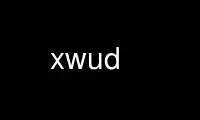
This is the command xwud that can be run in the OnWorks free hosting provider using one of our multiple free online workstations such as Ubuntu Online, Fedora Online, Windows online emulator or MAC OS online emulator
PROGRAM:
NAME
xwud - image displayer for X
SYNOPSIS
xwud [-in file] [-noclick] [-geometry geom] [-display display] [-new] [-std <maptype>]
[-raw] [-vis <vis-type-or-id>] [-scale] [-help] [-rv] [-plane number] [-fg color] [-bg
color] [-dumpheader]
DESCRIPTION
Xwud is an X Window System image undumping utility. Xwud allows X users to display in a
window an image saved in a specially formatted dump file, such as produced by xwd(1).
OPTIONS
-bg color
If a bitmap image (or a single plane of an image) is displayed, this option can be
used to specify the color to display for the "0" bits in the image.
-display display
This option allows you to specify the server to connect to; see X(7).
-dumpheader
This option prints out the XWD header information only. Nothing is displayed.
-fg color
If a bitmap image (or a single plane of an image) is displayed, this option can be
used to specify the color to display for the "1" bits in the image.
-geometry geom
This option allows you to specify the size and position of the window. Typically
you will only want to specify the position, and let the size default to the actual
size of the image.
-help Print out a short description of the allowable options.
-in file
This option allows the user to explicitly specify the input file on the command
line. If no input file is given, the standard input is assumed.
-new This option forces creation of a new colormap for displaying the image. If the
image characteristics happen to match those of the display, this can get the image
on the screen faster, but at the cost of using a new colormap (which on most
displays will cause other windows to go technicolor).
-noclick
Clicking any button in the window will terminate the application, unless this
option is specified. Termination can always be achieved by typing 'q', 'Q', or
ctrl-c.
-plane number
You can select a single bit plane of the image to display with this option.
Planes are numbered with zero being the least significant bit.
-raw This option forces the image to be displayed with whatever color values happen to
currently exist on the screen. This option is mostly useful when undumping an
image back onto the same screen that the image originally came from, while the
original windows are still on the screen, and results in getting the image on the
screen faster.
-rv If a bitmap image (or a single plane of an image) is displayed, this option forces
the foreground and background colors to be swapped. This may be needed when
displaying a bitmap image which has the color sense of pixel values "0" and "1"
reversed from what they are on your display.
-scale Allow the window to be resized, and scale the image to the size of the window.
-std maptype
This option causes the image to be displayed using the specified Standard
Colormap. The property name is obtained by converting the type to upper case,
prepending "RGB_", and appending "_MAP". Typical types are "best", "default", and
"gray". See xstdcmap(1) for one way of creating Standard Colormaps.
-vis vis-type-or-id
This option allows you to specify a particular visual or visual class. The
default is to pick the "best" one. A particular class can be specified:
"StaticGray", "GrayScale", "StaticColor", "PseudoColor", "DirectColor", or
"TrueColor". Or "Match" can be specified, meaning use the same class as the
source image. Alternatively, an exact visual id (specific to the server) can be
specified, either as a hexadecimal number (prefixed with "0x") or as a decimal
number. Finally, "default" can be specified, meaning to use the same class as the
colormap of the root window. Case is not significant in any of these strings.
ENVIRONMENT
DISPLAY To get default display.
Use xwud online using onworks.net services
